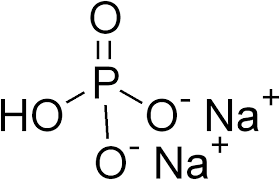Pharmaceutical & Fine Chemicals
Disodium Phosphate

Product Description
Disodium phosphate, also known as sodium phosphate dibasic, is a versatile compound with various industrial applications.
Product:
Disodium Phosphate
CAS:
7558-79-4
Synonym:
Sodium phosphate dibasic; Disodium hydrogen phosphate
Structure:

Typical Characteristics
Appearance
Colorless to white crystalline powder
Density
1.7 g/cm3
Melting point
250 °C (decomposes)
Molecular Weight
141.96
Odor
Odorless
Purity
≥99%
Refractive index
1.3564-1.3572
Uses, Applications & Markets
Key applications
get a quote
We Offer Disodium Phosphate
in various grades
A few of the grades available are listed below:



Disodium Phosphate used in many
industry applications
Disodium phosphate, also known as sodium phosphate dibasic, is a versatile compound with various industrial applications. Here are some of its uses:
- Food Additive: Disodium phosphate is commonly used as a food additive, primarily as a buffering agent, emulsifier, and texturizer. It helps regulate acidity and pH levels in processed foods, enhances moisture retention in meat and poultry products, and improves the texture and stability of dairy and baked goods.
- Water Treatment: Disodium phosphate is employed in water treatment processes as a sequestering agent and corrosion inhibitor. It helps prevent the formation of scale and mineral deposits in boilers, cooling towers, and water distribution systems. It also inhibits corrosion of metal surfaces by forming a protective film.
- Detergents and Cleaners: Disodium phosphate is used in household and industrial detergents and cleaners as a builder and surfactant. It enhances the cleaning effectiveness of detergents by softening water, suspending soil particles, and preventing re-deposition of dirt on surfaces. It is effective in removing grease, oil, and other contaminants from various surfaces.
- Buffering Agent: Disodium phosphate is employed as a buffering agent in pharmaceuticals, cosmetics, and personal care products to maintain pH stability and improve product performance. It helps regulate the acidity or alkalinity of formulations, ensuring consistency and compatibility with skin and mucous membranes.
- Electroplating: Disodium phosphate is utilized in electroplating baths as a buffering agent and pH adjuster. It helps maintain the desired pH level of plating solutions, ensuring uniform deposition of metal coatings on substrates. It also aids in controlling the concentration of metal ions and optimizing plating efficiency.
- Fire Retardants: Disodium phosphate may be incorporated into fire-retardant formulations for textiles, wood, and plastics. It acts as a flame retardant by releasing water vapor and other fire-suppressing gases when exposed to high temperatures, helping to extinguish fires and inhibit their spread.
- Photography: Disodium phosphate is used in the photographic industry as a buffering agent and pH regulator in developing solutions. It helps maintain the optimal pH range for the development of photographic films and papers, ensuring proper image formation and tonal reproduction.